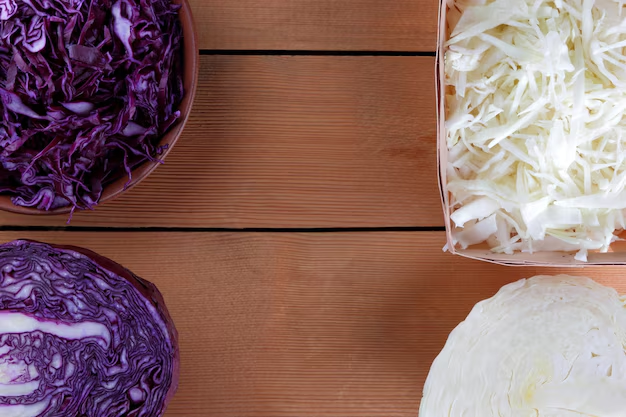How Long Can You Keep Cabbage Fresh in the Refrigerator?
Cabbage is a versatile vegetable found in a variety of dishes worldwide, from comforting coleslaws to savory stir-fries. Its impressive shelf life also makes it a popular choice for those who love to stock up on produce. However, understanding how long cabbage can last in your refrigerator and how to store it properly is key to maximizing its longevity and flavor. Let's dive deep into the world of cabbage storage, unveiling tips and guidance to help you make the most out of this leafy green.
🥦 The Basics of Cabbage Storage
Cabbage is a hardy vegetable known for its ability to stay fresh longer than many other produce options. When kept in optimal conditions, cabbage can endure weeks in your refrigerator, sometimes even surpassing a month without significant quality loss. Factors like the type of cabbage, how it's stored, and the condition of the cabbage when purchased all play a role in its shelf life.
Types of Cabbage
Before we delve into storage tips, it's important to note the different types of cabbage and how each might impact storage:
- Green Cabbage: The most common variety, with a heavy, dense feel and bright, crisp leaves.
- Red Cabbage: Similar to green cabbage in structure but with a distinctive purple hue and slightly peppery taste.
- Savoy Cabbage: Recognizable by its crinkled, tender leaves, offering a milder flavor.
- Napa Cabbage: Often used in Asian cuisine, this cabbage has a more delicate structure and a slightly sweeter taste.
Each type requires similar storage methods, but the inherent structure and texture can affect longevity.
🌡️ Optimal Storage Conditions
For maximum freshness, storing cabbage in the coldest part of your refrigerator, ideally in the crisper drawer, will help retain its natural moisture while preventing it from freezing.
Keeping It Fresh
Here are some practical tips for ensuring your cabbage stays fresh:
- Don’t Wash Before Storing: Moisture can promote decay. Wash cabbage only when you're ready to use it.
- Use Plastic or Mesh Bags: Seal the cabbage in a perforated plastic bag or a simple mesh bag to breathe, which helps to prevent excess moisture accumulation.
- Avoid Damaged Leaves: Discard any damaged or wilted outer leaves to keep the inner leaves protected and crisp.
General Shelf Life Estimates
- Whole Cabbage: Typically stays fresh for up to 3-4 weeks.
- Cut Cabbage: Use within 1-2 days as it loses freshness faster once sliced.
🍽️ Preparing and Using Cabbage
Beyond storage, knowing how to handle cabbage for cooking is crucial. Cabbage is not only cost-effective but also nutritionally rewarding, rich in vitamins K and C, fiber, and other antioxidants.
Cooking Tips
- Chop Just Before Cooking: To preserve nutrients and prevent oxidation.
- Versatile Usage: Perfect for steaming, boiling, sautéing, or eating raw in salads.
Here's a quick table summarizing different ways to use cabbage:
| Cooking Method | Ideal Dish |
|---|---|
| Raw | Salads, Coleslaw |
| Steamed | Side Dishes, Dim Sum |
| Boiled | Soups, Stews |
| Sautéed | Stir-Fries, Tacos |
| Fermented | Sauerkraut, Kimchi |
🛒 Shopping for Best Quality
When selecting cabbage, choose a head that feels firm and heavy for its size, with tightly bound leaves that are crisp and vibrant. Avoid heads with wilted or discolored leaves as these may spoil quicker.
Enhanced Storage Techniques
- Blanching for Freezing: If you wish to freeze cabbage, blanch it quickly in boiling water and then plunge it into ice water. This will help maintain its color and nutritional value.
- Regular Checks: Make it a habit to check your cabbage regularly for any signs of wilt or spoilage and remove any compromised leaves.
🚫 Signs It’s Time to Toss
Even with the best of storage methods, cabbage doesn’t last indefinitely. Watch out for these indicators that your cabbage is past its prime:
- Discoloration: Brown spots and faded leaves.
- Slimy Texture: An overly soft texture is an indicator of spoilage.
- Foul Odor: Any sour or unpleasant smell suggests it’s time to discard the cabbage.
🤔 Can You Use Cabbage Beyond Its Freshness?
Waste not, want not! Here are some creative uses for slightly older cabbage:
- Fermented Creations: Perfect for turning into sauerkraut or kimchi, utilizing its natural fermentation properties.
- Soups and Stews: Cabbage that has softened a bit can be cooked down in soups or casseroles.
📋 Summary of Key Points
For a quick and easy recap, check out the following bullet-list:
- 🥶 Storage: Keep cabbage in the coldest part of the fridge, ideally in a perforated bag.
- 🏷️ Shelf Life:
- Whole: Up to 3-4 weeks
- Cut: 1-2 days
- ⚠️ Warning Signs: Discoloration, slime, or bad odors signal it's time to toss.
- 🔄 Alternatives: Older cabbage is perfect for ferments or hearty soups.
Keeping these insights in mind will not only prolong the life of your cabbage but also ensure every bite is flavorful and nutritious. By applying proper storage techniques and recognizing when it's time to use or lose, you harness both the immediate and extended benefits of this remarkable vegetable. Enjoy the fresh crunch in salads, the richness in stir-fries, and the zest in pickling—all while reducing waste in your kitchen. Happy cooking!
